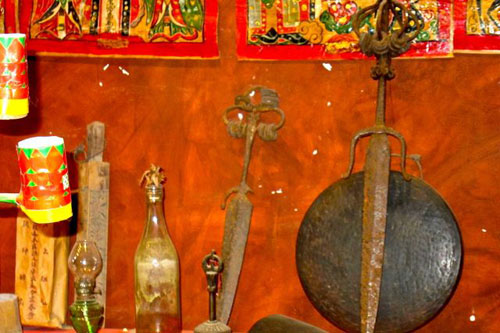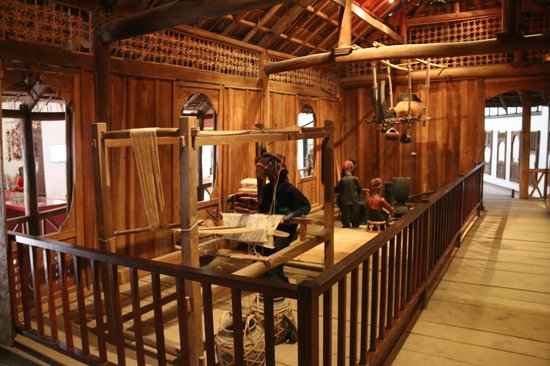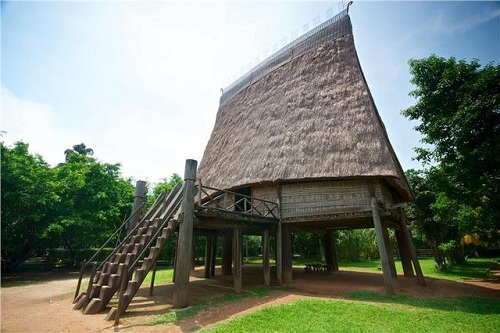Published: 10:47 Wednesday - October 13, 2010
Vietnam Museum of Ethnology is both a research centre and a public museum exhibiting the ethnic groups of Vietnam. The mission of the Museum is scientific research, collection, documentation, conservation, exhibition and preserving the cultural and historic patrimony of the nation’s different ethnic groups. The museum also serves to guide research, conservation, and technology that are specific to the work of an ethnographic museum. In its planning for the future, the Museum intends to present the cultures and civilisations of other countries of South-East Asia as well as in the region.
Vietnam is a multi-ethnic country, which is composed of 54 ethnic groups. Perceiving the importance of having an ethnographic museum to preserve and present the cultural heritages of ethnic groups, the Government decided to establish a museum of ethnology in Hanoi. The Proposal for the Vietnam Museum of Ethnology was officially approved on December 14, 1987. Land was allocated for construction: in 1987, 2,500m2 and in 1988, 9,500m2. Then, in 1990, the Prime Minister decided to allocate the entire 3,27 acres of land to the Museum.

During construction (1987 to 1995), the Project Managing Board and the Museum Department were a part of the Institute of Ethnology. On October 24, 1995, the Prime Minister made the decision on establishment of the Vietnam Museum of Ethnology, under National Centre for Social Sciences and Humanities. On November 12, 1997, the Vietnam Museum of Ethnology inaugurated its permanent exhibition and officially opened to the public.
The Museum is located in a large open area on Nguyen Van Huyen Street, Cau Giay District, about 8 km from the city centre. This area used to be paddy field of the local people. During the construction of the Museum, all of the infrastructure was built, including the 700m road from Hoang Quoc Viet Street to the entrance of the Museum. (In the near future, this road will reach the Daewoo Hotel, which is situated between Cau Giay and Lieu Giai Streets).

The Vietnamese Government first invested in the Museum in 1986 and construction of the foundation began in late 1989. According to the proposal, the total budget for construction was 27 billion of Vietnamese dong (US$ 1.9 million), not including 4 billion dong (US$ 285,000) for collecting and exhibiting the artefacts.
The exhibition building of the Museum was designed by the architect Ha Duc Linh, a Tay minority, who works for the Living Houses and Public Works Building Company, Ministry of Construction. The interior architecture was done by Mrs. Veronique Dollfus, a French architect.
The Museum is divided into two parts: an indoor and an outdoor exhibition. The indoor part is composed of the exhibition building, office, research centre, library, storage, technical lab and auditorium. These offices cover 2,480m2, including 750 m2 for storage of artefacts. The outdoor exhibition, which will be accomplished in the first years of the 21st century, is to highlight different types of houses in all parts of Vietnam. Pathways link the indoor and outdoor exhibitions with each other.
Since its inauguration on the occasion of the 7th Summit of Francophony in Hanoi, give date the Museum receives about 60,000 visitors annually.
What is new at the Vietnam Museum of Ethnology?
The Vietnam Museum of Ethnology is a valuable centre for the exhibition and the preservation of cultural heritages of the 54 ethnic groups in Vietnam. To date, the Museum has collected 15,000 artefacts, 2,190 slides, 42,000 photographs, 237 audiotapes, 373 videotapes and 25 CD-ROMs. It is also a centre for ethnographic research employing many experts on the different ethnic groups. People come to the Museum just not to visit or entertain, but also to learn about these ethnic groups, their cultural diversity and the uniqueness of each group and region, as well as traditional values throughout the Vietnamese country. For this reason, national and international visitors, children and students, professionals and non-professionals are attracted to the Museum.

The artefacts of the Museum are not only priceless antiquities, but many are everyday objects, such as knives, baskets, garments, flutes, pipes and mats. These objects reflect tangible and intangible cultural heritages of the communities, representing lives and creative activities of the people. Thus, artefacts of the Museum are so varied that they are organised into different collections. The Museum has 54 collections of each individual ethnic group. Functionally classified, there are collections of clothing, jewellery, of agricultural tools, fishing instruments, weapons, household utensils and musical instruments. In addition, there are collections of artefacts related to the various religions, beliefs, wedding ceremonies, funeral ceremonies and other social and spiritual activities. Based on the specific collections, the Museum organises exhibitions and publishes books and catalogues in different formats in order to meet the needs of various audiences of different backgrounds.
The two-floor building, which is inspired by the Vietnamese famous and ancient bronze drum, holds the permanent collection. A granite bridge leads from the main gate to the entrance of the exhibition, creating a feeling of going up to a house-on-stilts which is very popular in many areas of Vietnam. On entering the Museum, the granite floor is decorated with dark tiles arranged in the shape of an S. This decoration symbolises the shape of the Vietnamese coastline, the earth is in dark colour and the ocean is light grey.
The Vietnam Museum of Ethnology has been designed to reflect the country's technical and scientific progress as well as the Museum’s objectives. First of all, the Museum was created for everybody. This is reflected in both the architecture and the display techniques. The Museum has ramps for physically challenged people and an electric elevator allowing access to the second floor. All steps have handrails that are very comfortable for older people. Learning from the experiences of many museums in the world, the museum texts are not in capital letters but small letters so that it is easy for people of different ages to read them. Panels are presented at reasonable heights, for both adults and children. In addition to objects, there are photographs, texts, videos and many reference materials, all of which can be brought into full play to inform visitors with different levels of education and different needs.
The objects are displayed as centrepieces because they reflect the everyday lives of the people. The Museum’s consistent point of view is that the display should be simple, so that visitors can admire the beauty and finesse of each ordinary and simple item. Although there are no illustrative paintings in the Museum, photographs and videos are used to illustrate people’s lives.
A restricted number of 700 objects and 280 photographs are displayed in the Museum’s permanent exhibits, which helps
visitors avoid being distracted by an over-representation of artefacts. The different collections are displayed according to language groups and territories. Most of the objects presented in the 97 showcases are original. The showcases have either one-sided windows or four-sided windows, depending on the artefacts presented. For example, some cases present many artefacts; others have only one significant object. Among the showcases in the display, 50 cases are accompanied by texts. Each object has a label denoting its name, the ethnic group and the place where it was created. There are also mannequins, maps, graphs, hardcover books, photographs, videotapes, cassette tapes, models, and 33 section panels. Though the Museum is not large, dioramas highlight certain customs or cultural features of ethnic groups.
Adding to the many layers of information available to visitors, the museum provides hundreds of panels composed of explanations, illustrative photographs and maps. Unfortunately, because of limited space, the texts are condensed. Not only do the texts and the object labels serve a national audience, they are also translated into English and French in order to facilitate international visitors. Thus, visitors experiencing the museum, even without a tour guide, are able to understand the main messages of the displays.
New technical solutions have been used throughout the Museum, such as focused lights. The light radiates inside and outside the glass windows focusing on the most significant aspect of each object in order to set off its beauty and draw visitors’ attention. In addition, a ventilation system has been installed within each display area to protect the objects from mould and decay.
The outdoor exhibition area is only large enough for the most popular architectural styles to be represented. Already presented are the Ede long house, the Tay stilt house, the Yao house half on stilts, half on earth, the Hmong house whose roof is made of pomu wood, the Viet house with tile roof and the Giarai tomb. There are future plans to present the Bahnar communal house, the Cham traditional house and the Hanhi house made with beaten walls. Between the houses, there are trees indigenous to the area of each house, zigzagging paths and a meandering stream crossed by small bridges. The outdoor museum is being realised step by step.
Source: www.vme.org.vn
(84-63) 3 826042 – (84-63) 3 511142
No 54 Nguyen Dinh Chieu, Ham Tien Central Mui Ne Beach Binh Thuan Vietnam
523 To Hien Thanh District 10 Ho Chi Minh City Vietnam
Ha Long Halong City Quang Ninh Vietnam
A13 Hung Thong 2 Halong City Quang Ninh Vietnam




